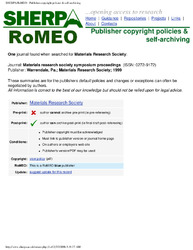| dc.contributor.author | Raffaelle, Ryne | en_US |
| dc.contributor.author | Gennett, Thomas | en_US |
| dc.contributor.author | Lau, J. | en_US |
| dc.contributor.author | Jenkins, P. | en_US |
| dc.contributor.author | Castro, Stephanie | en_US |
| dc.contributor.author | Tin, P. | en_US |
| dc.contributor.author | Wilt, D. | en_US |
| dc.contributor.author | Pal, A. | en_US |
| dc.contributor.author | Bailey, Sheila | en_US |
| dc.date.accessioned | 2006-07-19T19:56:22Z | en_US |
| dc.date.available | 2006-07-19T19:56:22Z | en_US |
| dc.date.issued | 2003 | en_US |
| dc.identifier.citation | Symposium G: Spatially Resolved Characterization of Local Phenomena in Materials and Nanostructures 738 (2003) G3.3.1-G3.3.7 | en_US |
| dc.identifier.uri | http://hdl.handle.net/1850/2220 | en_US |
| dc.description | Article may be found at: http://www.mrs.org/s_mrs/bin.asp?CID=2556&DID=58964&DOC=FILE.PDF | en_US |
| dc.description.abstract | The ability to determine the in-situ optoelectronic behavior of semiconductor materials has become especially important as the size of device architectures are reduced and the development of complex microsystems has increased. Scanning Tunneling Optical Resonance Microscopy or STORM has the ability to interrogate the optical bandgap as a function of position within a semiconductor microstructure. This technique uses a tunable solid-state Ti sapphire laser whose output is “chopped” using a spatial light modulator and is coupled by a fiber optic to a scanning tunneling microscope in order to illuminate the tip-sample junction. The photoenhanced portion of the tunneling current is spectroscopically measured using a lock-in technique. The capabilities of this technique were verified using semiconductor microstructure calibration standards that were grown by organometallic vapor phase epitaxy (OMVPE) at the NASA Glenn Research Center. Bandgaps characterized by STORM measurements were found to be in good agreement with the bulk values determined by transmission spectroscopy, photoluminescence, and with the theoretical values that were based on x-ray diffraction results. | en_US |
| dc.description.sponsorship | The authors would like to thank NASA for support of this work under contract NCC3-937, the Dept. of Energy project DE-FG02-02ER63393, and the National Science Foundation project number ECS-0233776. | en_US |
| dc.format.extent | 26759 bytes | en_US |
| dc.format.mimetype | application/pdf | en_US |
| dc.language.iso | en_US | en_US |
| dc.publisher | Materials Research Society Proceedings: 2002 Fall Meeting: Symposium G | en_US |
| dc.subject | Microstructures | en_US |
| dc.subject | Optoelectronics | en_US |
| dc.subject | Semiconductors | en_US |
| dc.title | Scanning tunneling optical resonance microscopy (STORM) | en_US |
| dc.type | Abstract | en_US |

